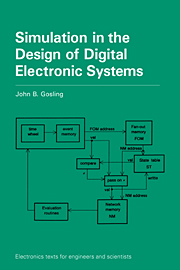Book contents
- Frontmatter
- Contents
- Preface
- 1 An introduction to the simulation of electronic systems
- 2 Electronic computer aided design (ECAD) systems
- 3 Design for testability
- 4 Exercising the design in simulation and test
- 5 Input/output of simulation and specification of models
- 6 Simulation algorithms
- 7 Models and model design
- 8 Timing verification
- 9 Fault simulation
- 10 Simulator features and extensions
- Appendix
- References
- Index
10 - Simulator features and extensions
Published online by Cambridge University Press: 05 June 2012
- Frontmatter
- Contents
- Preface
- 1 An introduction to the simulation of electronic systems
- 2 Electronic computer aided design (ECAD) systems
- 3 Design for testability
- 4 Exercising the design in simulation and test
- 5 Input/output of simulation and specification of models
- 6 Simulation algorithms
- 7 Models and model design
- 8 Timing verification
- 9 Fault simulation
- 10 Simulator features and extensions
- Appendix
- References
- Index
Summary
The earlier chapters of this book discussed the design and use of a simulator for use in the development of digital electronic systems. The discussion has been widened to include some aspects of testing and design for testability, since application of good practice in these areas leads to better use of costly resources in what is probably the largest part of the design procedure. It is now of value to review the extent to which the aims of simulation can be achieved; to discuss several topics related to the use of simulator; to introduce some enhancements to simulators; and to attempt to look into the future.
Desirable features of a simulator
Some years ago the author wrote down a list of the features he would like to find in a simulator.
A simulator is required to give an accurate prediction of the behaviour of a good network.
A simulator is required to recognise and give warning of a faulty network.
The basic simulator should be independent of technology but recognise the distinctive features of known technologies. Thus devices of any technology might be simulated.
The simulator should be capable of handling modes at several levels of abstraction and in the same run (Harding 1989).
There is no point in simulating a design in 1 s if it takes a day to diagnose a fault, modify and recompile the network. Hence, associated with the simulator, there must be means to assist the user to find the source of ‘wrong’ results, correct them and recompile quickly. That is, the simulation cycle must be given serious attention (the detail is not within the scope of this book).
- Type
- Chapter
- Information
- Simulation in the Design of Digital Electronic Systems , pp. 243 - 257Publisher: Cambridge University PressPrint publication year: 1993



